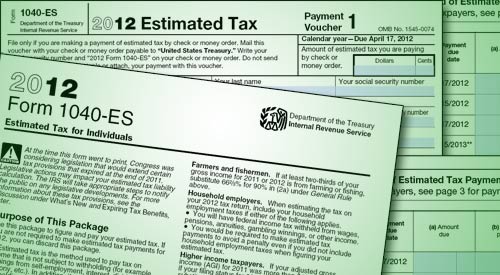If you’re self employed or if you have significant side income you most likely should be paying estimated taxes on the income throughout the year in order to avoid paying penalties come tax time. Our tax system is a pay as you go system, so if you’re making enough money to warrant it, you should be paying taxes throughout the year.
This past year I paid just enough in estimated taxes in order to satisfy the IRS safe harbor requirements, but come tax time I had underestimated how much I would owe in total in taxes, and ended up with a huge tax bill (in excess of $5000).
If you’re smart you’ll avoid doing what I did and make sure to accurately track how much income you’re making throughout the year and pay enough in federal, state and self employment taxes in order to not have to pay more than expected come tax time.
Today I want to take a look at estimated taxes, and talk about how they work, when they’re due and why you should be paying them.
Quick Navigation
Estimated Tax Payments: Who Should Pay Them?
People who work for an employer and receive a paycheck would normally have their taxes withheld from their paycheck, and their employer pays their taxes for them. If, however, the amount that is being withheld isn’t enough because you have income from investments, from side or part time jobs, or if you have income that isn’t subject to withholding, you might need to think about making estimated tax payments.
If you don’t want to have to pay penalties when tax time rolls around you’ll need to make sure that you’re estimating your income for the year and meeting one of the IRS safe harbor requirements to avoid penalties. To avoid penalties, do one of the 3 following things:
- Owe less than $1,000 for this year’s taxes.
- Withhold 100% of last year’s tax liability.
- Withhold 90% of this year’s tax liability.
You can meet the tax payment and safe harbor requirements by adjusting your tax withholding at your job, by making estimated tax payments, or both if you so choose. For example, if you figure out in the fourth quarter that you haven’t paid enough in estimated tax payments, you can increase your withholding at your job in order to meet safe harbor requirements.
Last year we did #2 from the above list and withheld 100% of our previous year’s tax liability in order to avoid penalties. Although we avoided penalties, we did have a big tax bill come April because our income was substantially higher than the previous year.
Paying Your Estimated Taxes
Paying estimated taxes can be a bit confusing the first couple of times that you do it, but it gets easier. The first payment is due on April 15th (or whatever day the personal income tax filing deadline is). To figure out and pay your estimated taxes you can follow this process:
- Complete the estimated tax worksheet, Form 1040-ES: Download Form 1040-ES from the IRS website and fill in the form to figure out how much you should pay. Some information that you’ll need handy when you fill complete the form include your previous year’s AGI (Adjusted Gross Income), deductions that you took, Net Income, etc. If the paper form seems a bit too confusing for you, a lot of the popular tax software will calculate and print out estimated tax coupons for you to use in paying your estimated taxes. I used TurboTax this past year, and it gave me payment coupons for federal and state estimated taxes due. I just keep those in our file and reference them when payments come due. For more detailed help or answer to frequently asked questions, check out Publication 505, Tax Withholding and Estimated Tax.
- Make your estimated tax payment, online or in the mail! If you haven’t already, sign onto the Electronic Federal Tax Payment System (EFTPS), and you can make your estimated tax payments online via direct bank debit. Make sure you don’t do this at the last minute because you’ll need a PIN to access the site, and it’ll take 15 days or more to arrive in the mail when you sign up. If you haven’t signed up for EFTPS in time, just find the paper payment coupon in Form 1040-ES, and mail that in along with your estimated tax payment. To make state estimated tax payments check with your local state to see if they accept online payments.
Due Dates For Estimated Tax Payments
Estimated tax payments need to be made 4 times a year in April, June, September and January. One thing that often confuses people is that the payments are spaced unevenly, not every three months like some people assume. They are spaced out 2 months, 3 months and 4 months apart.
- April 15 (same as tax filing day for personal income taxes)
- June 15
- September 15
- January 15
State Estimated Tax Payments And Self Employment Tax Due Also
Not only are federal taxes due on the dates mentioned above, but you’ll also need to pay your state estimated taxes as well as self employment taxes. While the self employment taxes for social security and Medicare are usually 15.3%, for 2011 and 2012 they have been cut by 2%, and are 13.3%.
So that means for 2012 you’re paying 10.4% for Social Security and 2.9% for Medicare. Unless something is done to extend the 2% payroll tax cut, the self employment tax will go back up to 15.3% in 2013.
More Estimated Tax Information
Need more detailed information about your estimated taxes? Check out the IRS resources listed below.
- IRS: Estimated Tax Information From IRS
- IRS: Publication 505, Tax Withholding and Estimated Tax
- IRS: Estimated Tax Form 1040-ES
Are you making estimated tax payments this year, or have you in past years? Do you find them confusing?


Share Your Thoughts: